What is Julia Sets?
This activity allows the user to investigate the Julia sets associated with functions f(Z) = Z^2 + C for any complex number C=(a,b) in the circle of radius 2.
To understand Julia sets and ultimately the Mandelbrot set -- the world's most famous fractal -- we need to be able to find the boundary between the prisoner and escapee sets for a particular C.
An example of a function is: f(Z) = Z^2 + (.5,.5). If we start with the point (0,0) and plug it into the function:
f(0,0) = (0,0)^2 + (.5,.5) = (0,0) + (.5,.5) = (.5,.5)
f(.5,.5) = (.5,.5)^2 + (.5,.5) = (0,.5) + (.5,.5) = (.5,1)
f(.5,1) = (.5,1)^2 + (.5,.5) = (-.75,1) + (.5,.5) = (-.25,1.5)
f(-.25,1.5) = (-.25,1.5)^2 + (.5,.5) = (-2.1875,-.75) + (.5,.5) = (-1.6875,-.25)
f(-1.6875,-.25) = (-1.6875,-.25)^2 + (.5,.5) = (2.7852,.84375) + (.5,.5) = (3.2852,1.34375)
Here is a picture:
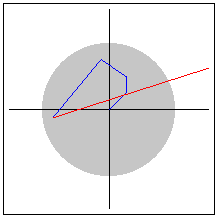
This is in the escapee set for C=(.5,.5). If we continue this process for lots of points we can get a feel for the picture of the Julia set. For C=(.5,.5) we get:
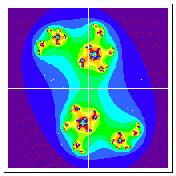
Notice that there are no black areas on this image. (Black would denote the prisoners.) There are prisoners, but they are completely scattered around and isolated from each other. This forces the Julia set -- the points that neither are prisoners or escapees -- to be completely disconnected from each other. The other colors on the picture are the escapees, and the different colors denote how quickly the point's orbit jumped out of the circle of radius 2.
Here's another one with an obvious prisoner set; C = (0,0).
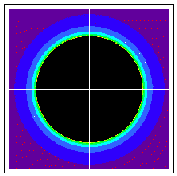
This has a nice big connected set of prisoners -- giving a connected Julia set, the circle of radius 1. Mandelbrot found that these are the only two things that happen, either the Julia set is fractal dust (totally disconnected) or it is one piece.
Here are a few of the more popular Julia sets:
C = (-1,0):
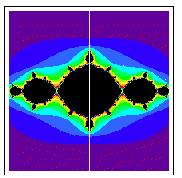
C = (-.1,.8):
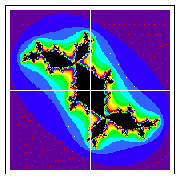
C = (.5,0):
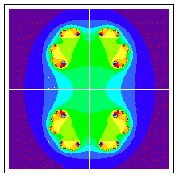
C = (-.8,.4):
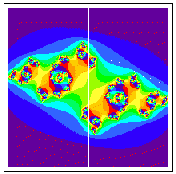
The first two are connected and the last two are fractal dust. This is the basis for the Mandelbrot set.
How Do I Use This Activity?
This activity allows the user to investigate the Julia sets associated with functions f(Z) = Z^2 + C for any complex number C=(a,b) in the circle of radius 2.
Controls and Output
- The rectangular area at the top of the screen is where the Julia set is drawn. Black points are prisoners; colored points are escapees (color differences indicate how quickly they escape from the circle of radius 2).
-
The
Constant text box at the bottom is for the value of C for which you are interested in viewing the
Julia set. To change the C value, either click the up/down arrows or enter a number
directly in the text field. For best results, keep the C value under 2.

-
Press the
Draw button to clear the current Julia Set and draw a new one with the entered values for the
constant. Since the Set is redrawn with each press of an up/down arrow, the only time this
button will make a change to the graph is when numbers have been directly entered into the
text fields (without the pressing of the arrow buttons).

-
The
Change Step Size button changes the amount by which the C value increases each time you click the up or
down arrow.

Description
This activity allows the user to investigate the Julia sets associated with functions f(Z) = Z^2 + C for any complex number C=(a,b) in the circle of radius 2. This activity would work well in groups of two to four for about twenty-five minutes if you use the exploration questions and ten minutes otherwise.
Place in Mathematics Curriculum
This activity can be used to:
- practice students' arithmetic skills
- practice students' point plotting skills
- introduce students to complex numbers
- investigate the notions of Julia sets, prisoners and escapees
- motivate the Mandelbrot set
Standards Addressed
Grade 6
-
Geometry
- The student demonstrates conceptual understanding of similarity, congruence, symmetry, or transformations of shapes.
Grade 7
-
Geometry
- The student demonstrates conceptual understanding of similarity, congruence, symmetry, or transformations of shapes.
Grade 8
-
Geometry
- The student demonstrates conceptual understanding of similarity, congruence, symmetry, or transformations of shapes.
Grade 9
-
Geometry
- The student demonstrates an understanding of geometric relationships.
- The student demonstrates conceptual understanding of similarity, congruence, symmetry, or transformations of shapes.
- The student demonstrates a conceptual understanding of geometric drawings or constructions.
Grade 10
-
Geometry
- The student demonstrates an understanding of geometric relationships.
- The student demonstrates conceptual understanding of similarity, congruence, symmetry, or transformations of shapes.
- The student demonstrates a conceptual understanding of geometric drawings or constructions.
Number and Quantity
-
The Complex Number System
- Perform arithmetic operations with complex numbers.
- Represent complex numbers and their operations on the complex plane.
Grades 9-12
-
Algebra
- Understand patterns, relations, and functions
-
Geometry
- Use visualization, spatial reasoning, and geometric modeling to solve problems
-
Measurement
- Apply appropriate techniques, tools, and formulas to determine measurements
Grade 8
-
Number and Operations, Measurement, Geometry, Data Analysis and Probability, Algebra
- COMPETENCY GOAL 3: The learner will understand and use properties and relationships in geometry.
Introductory Mathematics
-
Data Analysis and Probability
- COMPETENCY GOAL 3: The learner will understand and use properties and relationships in geometry.
-
Geometry and Measurement
- COMPETENCY GOAL 2: The learner will use properties and relationships in geometry and measurement concepts to solve problems.
Geometry
-
Geometry and Measurement
- Competency Goal 2: The learner will use geometric and algebraic properties of figures to solve problems and write proofs.
Algebra II
-
Algebra
- Competency Goal 2: The learner will use relations and functions to solve problems.
-
Numbers and Operations
- Competency Goal 1: The learner will perform operations with complex numbers, matrices, and polynomials.
Technical Mathematics I
-
Geometry and Measurement
- Competency Goal 2: The learner will measure and apply geometric concepts to solve problems.
Technical Mathematics II
-
Geometry and Measurement
- Competency Goal 1: The learner will use properties of geometric figures to solve problems.
Advanced Functions and Modeling
-
Algebra
- Competency Goal 2: The learner will use functions to solve problems.
Discrete Mathematics
-
Algebra
- Competency Goal 3: The learner will describe and use recursively-defined relationships to solve problems.
Integrated Mathematics III
-
Algebra
- Competency Goal 3: The learner will use relations and functions to solve problems.
-
Geometry and Measurement
- Competency Goal 2: The learner will use properties of geometric figures to solve problems.
Integrated Mathematics IV
-
Algebra
- Competency Goal 4: The learner will use relations and functions to solve problems.
-
Number and Operations
- Competency Goal 1: The learner will operate with complex numbers and vectors to solve problems.
Be Prepared to
- give implicit directions on what they are to do. For example "Today we are going to find out about prisoners, escapees, and complex numbers by using the Julia set activity as well as the Two Variable Function Pump and the Julia set worksheet..."
- answer the question "What is a prisoner and what is an escapees?"
- discuss complex numbers, and how to plot points